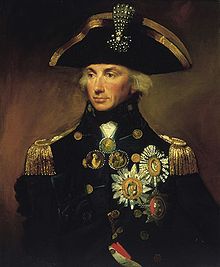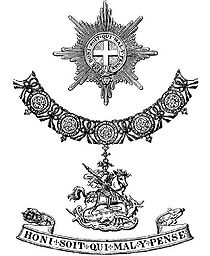- Order (honour)
-
 In Lemuel Francis Abbott's portrait Admiral Horatio Nelson wears embroidered replicas of his orders on his coat.
In Lemuel Francis Abbott's portrait Admiral Horatio Nelson wears embroidered replicas of his orders on his coat. The insignia of a knight of the Order of the Garter.
The insignia of a knight of the Order of the Garter.
An order or order of merit is a visible honour, awarded by a government, dynastic house or international organization to an individual, usually in recognition of distinguished service to a nation or to humanity. The distinction between orders and decorations is somewhat vague, except that most historic orders imply a membership in a group. In the case of most European orders, membership was also limited in number. Decorations have no such limitations, and are awarded purely to recognize the merit or accomplishments of the recipient. Both orders and decorations often come in multiple classes.[1]
Contents
Development
Modern orders of merit and decorations can trace their origin back to the monarchical and honorific orders of chivalry as established in the Middle Ages. While these were "societies, fellowships and colleges of knights",[2] created by European monarchs in imitation of the military orders of the Crusades, granting membership in such societies gradually developed into an honour that could be bestowed in recognition of service or to ensure the loyalty of a certain clientele. Some of modern Europe's highest honours, such as the Order of the Golden Fleece, England's Order of the Garter, Denmark's Order of the Elephant and Scotland's Order of the Thistle, were created during that era. They were essentially courtly in nature, characterised by close personal relations between the orders' members and the orders' sovereign.
By the time of the Renaissance, most European monarchs had either acquired an existing order of chivalry, or created new ones of their own, to reward loyal civilian and especially military officials. Such orders remained out of reach to the general public, however, as being of noble rank or birth was usually a prerequisite to being admitted. In the 18th century, these ideas gradually changed and the orders developed from "honourable societies" to "visible honours". An example of this gradual development can be seen in two orders founded by Maria Theresa of Austria. While the Military Order of Maria Theresa (1757) was open to any deserving military officer regardless of social origin, and would grant titles of nobility to those who did not already have them, the Order of Saint Stephen of Hungary (1764) still required that one had to have at least four generations of noble ancestors.
In 1802 Napoleon created the Légion d'honneur (Legion of Honour), which could be awarded to any person, regardless of status, for bravery in combat or for 20 years of distinguished service. While still retaining many trappings of an order of chivalry, it was the first modern order of merit and is still France's highest award today. The French Legion of Honour served as the model for numerous modern orders of merit in the Western World, such as the Order of Leopold (Belgium, 1832) and the Order of the British Empire (United Kingdom, 1917). The orders based on the French Legion of Honour typically have five classes (see below).
In Communist countries orders of merit usually came in one to three grades, with only a badge worn with or without a ribbon on the chest. An example of a Communist order of merit was the one-class Order of Lenin (USSR, 1930). Unlike the Western orders, however, Communist orders could be awarded more than once to an individual. After the collapse of the Soviet bloc most Eastern European countries have reverted to the Western-style order of merit originally established before the rise of Communism.
Modern ranks
Following the example set by the French Legion of Honour, most multi-level European orders comprise five ranks or classes. The highest is usually called the Grand Cross, then descending with varying titles. Typical rankings are
- Grand Cross (or Grand Cordon, Grand Collar etc.)
- Grand Officer (Grand Commander, Knight Commander, Knight Companion)
- Commander (Companion)
- Officer
- Knight (Chevalier, Member)
Each of these ranks wear insignia, usually badge (often enamelled) on a ribbon. Typically these insignia are worn from a sash in the case of the senior ranks, around the neck (also see neck orders) for the middle ranks and on the left chest for the lower grades. Some orders use insignia in the form of a cross, but there can also be medals or stars, military awards may have crossed swords added onto the insignias. Ladies may wear the badge on a bow on the left chest. In orders following the example set by the French Legion of Honour, the two highest classes also wear a star (or 'plaque') on the chest. In special cases the senior class may wear the badge on a collar, which is an elaborate chain around the neck.
Orders worldwide
Today almost all countries have some form of order of merit or country decorations. Both Thailand's Order of the White Elephant and Japan's Order of the Rising Sun are over 100 years old. Canada has the Order of Canada; Australia similarly has the Order of Australia. The United States awards the Medal of Honor to members of its military for particular acts of valour. The Presidential Medal of Freedom and the Congressional Gold Medal are the highest awards presented by the United States to civilians. The Legion of Merit is the only United States decoration which may be issued in award degrees (much like an Order of chivalry or certain Orders of Merit), but this is only done in the case of awards to foreign nationals (typically senior military officers or government officials). When awarded to U.S. military personnel the Legion of Merit is presented without reference to degree.
Switzerland does not award any orders, and the Swiss Constitution excludes Swiss citizens accepting orders from foreign governments from holding any sort of public office.[citation needed]
In 1974 the Swedish government passed a resolution forbidding the King of Sweden from awarding membership in orders to Swedish citizens. This did not formally abolish the orders themselves, but today only the Order of Seraphim and the Order of the Polar Star (both established 1748) continue to be awarded, and only to foreign citizens. In 1995 this law was altered, allowing the Monarch to bestow the two remaining active Orders to members of the Swedish Royal Family.[3]
Modern orders are usually open to all citizens of a particular country, regardless of status, sex, race or creed (although some countries require their citizens to have reached a certain age before becoming eligible). Nominations are either made by private citizens, or by government officials, depending on the country. Once awarded, an order may be revoked if the individual dies, commits a crime, or renounces citizenship. Rarely, a dissident becomes awarded, and due to personal beliefs refuses to accept it.
See also
- Awards and decorations of the Russian Federation
- Awards and decorations of the Soviet Union
- Awards and decorations of the Kingdom of Belgium
- Awards and decorations of the German Armed Forces
- Civil decoration
- Commonwealth realms orders and decorations
- Dynastic Orders of Knighthood
- List of military decorations
- List of prizes, medals, and awards
- Military decoration
- Military order
- Neck order
- Ordre des Palmes Academiques
- Order of Saint Louis
- State decoration
References
- ^ Definition adapted from www.turkishmedals.net, accessed 2010-02-20.
- ^ "St. George's Chapel: History: Order of the Garter". See the definition of the Order of the Garter as "a society, fellowship and college of knights" there. - St. George's Chapel, Windsor Castle. 2005. Archived from the original on 15 September 2006. http://web.archive.org/web/20060915040604/http://www.stgeorges-windsor.org/history/hist_garter.asp. Retrieved 6 November 2006.
- ^ The Monarchy and the Royal Court (Kungahuset), The Orders in Sweden.
Categories:- Orders, decorations, and medals
- Orders of knighthood
Wikimedia Foundation. 2010.


